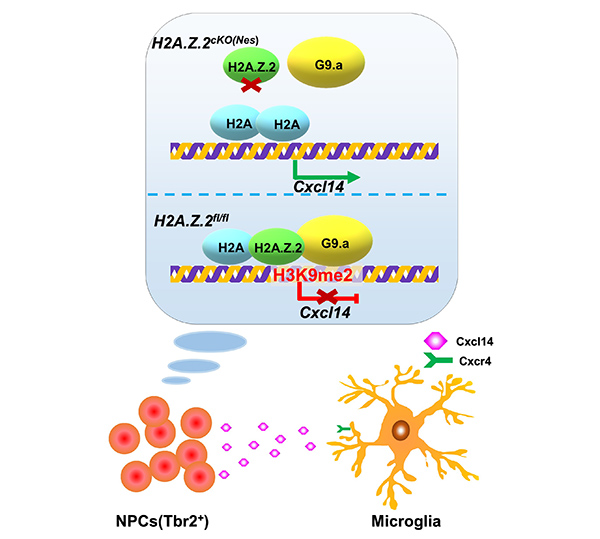Microglia, the resident immune cells of the central nervous system, play an important role in the brain and protect the brain from the invasion and destruction of virus and bacteria. Microglia are involved in brain damage, inflammation and neurodegenerative diseases. In addition to its role in adult physiological and pathological conditions, microglia exert the function in the whole stage of brain development. These important effects of microglia are related to their specific spatial and temporal distribution in the embryonic brain, but how microglia develop in the brain during neurogenesis, and whether neural stem cells affect the development of microglia are still unclear.
The Neural Stem Cell Proliferation and Differentiation Research Group in Institute of Zoology, Chinese Academy of Sciences, led by Prof. Jianwei Jiao, is mainly interested in studying neural stem cell development and glial cell development. The staining of mouse embryonic brain at different stages showed that microglia were distributed in the ventricular zone and subventricular zone (VZ/SVZ), which was abundant in the neural progenitor cells (NPCs) in the early embryonic brain, but there were few microglia in cortical plate area. Meanwhile, the histone variant H2A.Z.2 was observed to be abundantly expressed in the VZ/SVZ region. To further investigate whether H2A.Z.2 in NPCs can regulate the development of early microglia, they specifically knocked out H2A.Z.2 in NPCs and found that the deletion of H2A.Z.2 caused abnormal increase in microglia in the VZ/SVZ region. They also found that the deficiency of H2A.Z.2 in NPCs also promoted the transformation of radial glial cells into intermediate precursor cells in neural stem cells.
By RNA-seq analysis of H2A.Z.2 conditional knockout mice in NPCs, they found H2A.Z.2 was able to regulate the secretion of chemokine Cxcl14 in NPCs. It was first demonstrated that the chemokine Cxcl14 plays an important regulatory role in the development of microglia in the brain. H2A.Z.2, as one of the most important histone variants, affects chromatin structure involved in many biological processes such as transcriptional regulation, chromosome segregation, heterochromatin formation and genomic stability. H2A.Z.2 regulates the transcription of Cxcl14 by recruiting the H3k9 methyltransferase G9a to Cxcl14 promoter region, thereby affecting the development of microglia.
This study demonstrates that the NPCs mediated by H2A.Z.2 play a key role in regulating the development of early microglia, broadening the understanding of the interaction between two different types of cells in the central nervous system, and provides new ideas in exploring neuroimmunology-related diseases
Related research results were published online in Proc Natl Acad Sci U S A on November 11, 2019, as a research paper entitled "Neural progenitor cells mediated by H2A.Z.2 regulate microglial development via Cxcl14 in the embryonic brain" by direct submission. Zhongqiu Li is the first author and Jianwei Jiao is the corresponding author of the paper. The project is supported by the leading project of the Chinese Academy of Sciences, the national key R & D plan and the project of the National Natural Science Foundation of China.

Figure. Model of the regulation of the development of microglia in the early brain by H2A.Z.2.

